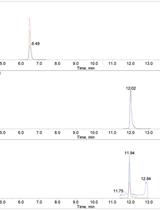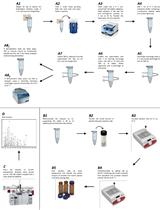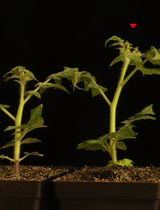- EN - English
- CN - 中文
Isolation of Intact Vacuoles from Petunia Petals and Extraction of Sequestered Glycosylated Phenylpropanoid Compounds
从矮牵牛花瓣中分离完整的液泡并提取分离糖基化苯丙素类化合物
(*contributed equally to this work) 发布: 2018年07月05日第8卷第13期 DOI: 10.21769/BioProtoc.2912 浏览次数: 8139
评审: Amey RedkarBen SpitzerGongjun Shi
Abstract
Plant vacuoles are the largest compartment in plant cells, occupying more than 80% of the cell volume. A variety of proteins, sugars, pigments and other metabolites are stored in these organelles (Paris et al., 1996; Olbrich et al., 2007). Flowers produce a variety of specialized metabolites, some of which are unique to this organ, such as components of pollination syndromes, i.e., scent volatiles and flavonoids (Hoballah et al., 2007; Cna'ani et al., 2015). To study the compounds stored in floral vacuoles, this compartment must be separated from the rest of the cell. To enable isolation of vacuoles, protoplasts were first generated by incubating pierced corollas with cellulase and macrozyme enzymes. After filtering and several centrifugation steps, protoplasts were separated from the debris and damaged/burst protoplasts, as revealed by microscopic observation. Concentrated protoplasts were lysed, and vacuoles were extracted by Ficoll-gradient centrifugation. Vacuoles were used for quantitative GC-MS analyses of sequestered metabolites. This method allowed us to identify vacuoles as the subcellular accumulation site of glycosylated volatile phenylpropanoids and to hypothesize that conjugated scent compounds are sequestered in the vacuoles en route to the headspace (Cna'ani et al., 2017).
Keywords: Vacuole (液泡)Background
Plant vacuoles occupy up to 80% of the cellular volume in plant cells. These organelles are essential for plant growth and development, with varied functions throughout the plant's life. Vacuoles compartmentalize different components, such as proteins, sugars, ions and specialized metabolites, and are involved in the plant's response to different developmental and environmental signals, e.g., stomatal opening, adaptation to cold, defense against herbivores and floral pigmentation (Shitan and Yazaki, 2013). Specific transporters are employed by vacuoles to allow penetration of inorganic ions and hydrophilic metabolites through the lipid bilayer membrane of the tonoplast (Schneider et al., 2012; Liu et al., 2015).
Specialized metabolites, including floral scent volatiles, are often produced and/or accumulated in sink organs, such as flower petals, glandular trichomes, root bark, etc. (Hanhineva et al., 2008; Kortbeek et al., 2016; Lashbrooke et al., 2016). Volatile phenylpropanoids and other specialized metabolites, e.g., flavonoids, monoterpenes, betalains, alkaloids and brassinosteroids, undergo various postproduction modifications, such as glycosylation, methylation and acylation. These modifications increase their stability, enable transport, lower their toxicity by blocking reactive groups and enhance their water solubility, thus enabling storage in subcellular compartments (Bowles et al., 2005; Dean et al., 2005). Glycosylated scent compounds are generally regarded as storage forms or precursors for the emission of aglycones at the appropriate time or stage of plant or organ development (Rambla et al., 2014). Floral scent has been studied extensively in the model plant Petunia. However, little is known about the intracellular fate of scent compounds. To this end, based on several previously described protocols from different plants/tissues (Robert et al., 2007; Fontes et al., 2010; Faraco et al., 2011 and 2014; Pérez-Díaz et al., 2014; Shen et al., 2014; Cna'ani et al., 2017), we generated a procedure for vacuolar isolation from petunia petals. Using a GC-MS–based protocol for isolating glycosylated volatiles from petal vacuoles, we were able to reveal a mechanism used by flowers to sequester volatile phenylpropanoids in vacuoles prior to their developmentally regulated emission to the environment.
Materials and Reagents
- Aluminum foil
- Cell strainer 100 μm nylon (Corning, catalog number: 431752 )
- Centrifuge tube 15 ml (Corning, catalog number: 430790 )
- Centrifuge tube 50 ml (Corning, catalog number: 430828 )
- Corning® bottle-top vacuum filter system (Corning, catalog number: 430796 )
- Cover slides 24 x 50 mm (Knittel Glass, catalog number: VD1 2450 Y100A )
- Cap for 4ml vial (J.G. Finneran, catalog number: 5360-13 )
- Finnpipette® pipette tips 5 ml (Sigma-Aldrich, Thermo Fisher, catalog number: P2924 )
- Glass insert (J.G Finneran, catalog number: 401BS-530 )
- Microscope slides 3 x 1 inch (Knittel Glass, catalog number: VA31100 001FKB )
- Non-sterile scalpel blades (Bar Naor, catalog number: BN10011-00 )
- Paper sheets (Romical, catalog number: 322-05004040 )
- PARAFILM® M sealing film (BRAND, catalog number: 701605 )
- Pasteur pipettes open tip 150 mm (Hilgenberg, catalog number: 3150101 )
- Petri dishes 90 x 15 mm (MINIPLAST, catalog number: 820-090-01-017 )
- Safe-Lock Tubes, 1.5 ml, Eppendorf QualityTM, colorless (Eppendorf, catalog number: 0030120086 )
- Safe-Lock Tubes, 2.0 ml, Eppendorf QualityTM, colorless (Eppendorf, catalog number: 0030120094 )
- Cap for 2 ml Vial (CHROMSERVIS, catalog number: 1076-8002-C )
- Silicone tubing 8 x 12 mm (Chen Samuel, catalog number: 054080120 )
- Sterile pipette 1 ml (Alexred, catalog number: ALP ON1E1 )
- Vial 2 ml (J.G Finneran, catalog number: 32008-1232 )
- Vial 4 ml (J.G. Finneran, catalog number: 34013-1545 )
- Ammonium nitrate (Sigma-Aldrich, catalog number: 256064 )
- Calcium chloride dihydrate (Merck, catalog number: 102382 )
- Cellulase R10 (Duchefa Biochemie, catalog number: C8001 )
- D-Mannitol (Sigma-Aldrich, catalog number: M4125 )
- Ethylenediaminetetraacetic acid disodium salt dihydrate (Sigma-Aldrich, catalog number: E6635 )
- Ficoll® PM 400 (Sigma-Aldrich, catalog number: F4375 )
- Fluorescein diacetate solution (Sigma-Aldrich, catalog number: F7378 )
- Gamborg’s B-5 Basal Salt Mixture (Sigma-Aldrich, catalog number: G5768 )
- HEPES (Sigma-Aldrich, catalog number: H7006 )
- Hydrochloric acid 37% (w/w) (Bio Basic, catalog number: HC6025 )
- Isobutyl benzene (Sigma-Aldrich, catalog number: 113166 )
- KCl (Sigma-Aldrich, catalog number: P4504 )
- Macrozyme R10 (Duchefa Biochemie, catalog number: M8002 )
- MES sodium salt (Sigma-Aldrich, catalog number: M3885 )
- Methyl alcohol (Sigma-Aldrich, catalog number: 322415 )
- n-Hexane HPLC (Biosolve, catalog number: 082906 )
- Sodium citrate tribasic dihydrate (Sigma-Aldrich, catalog number: C8532 )
- Sodium hydroxide (Sigma-Aldrich, catalog number: 221465 )
- Sodium hypochlorite 5% (Romical, catalog number: 73-7586-1400 )
- Sodium phosphate dibasic (Sigma-Aldrich, catalog number: 255793
- Sodium phosphate dibasic heptahydrate (Sigma-Aldrich, catalog number: S2429 )
- Sodium phosphate monobasic monohydrate (Sigma-Aldrich, catalog number: S3522 )
- Sterile double-distilled water (DDW)
- Sucrose (DAEJUNG CHMICAL & METALS, catalog number: 7501-4400 )
- Viscozyme (cellulolytic enzyme mixture) (Sigma-Aldrich, catalog number: V2010 )
- TEX buffer (see Recipes)
- Enzyme solution (see Recipes)
- Suspension buffer (see Recipes)
- 0.5 M EDTA, pH 8 (see Recipes)
- 30% Ficoll (see Recipes)
- 5% Ficoll (see Recipes)
- 0.2 M Sodium phosphate, pH 8 (see Recipes)
- Lysis buffer (see Recipes)
- 1 M Mannitol (see Recipes)
- 0.2 M Sodium phosphate, pH 7.5 (see Recipes)
- Vacuole buffer (0% Ficoll) (see Recipes)
- 80% Methyl alcohol (see Recipes)
- 0.1 M Citrate (see Recipes)
- 0.2 M Sodium phosphate dibasic (see Recipes)
- Citrate phosphate buffer, pH 5.4 (see Recipes)
- Isobutyl benzene 80 µg/ml (see Recipes)
- Hexane-standard solution (see Recipes)
Equipment
- Scalpel handle #3 (Bar Naor, catalog number: BN400-3-WH )
- Beaker 400 ml (Isolab Laborgeräte, catalog number: 025.01.400 )
- Beaker 600 ml (Isolab Laborgeräte, catalog number: 025.01.600 )
- FinnpipetteTM F3 variable volume single-channel pipettes 100-1,000 µl (Thermo Fisher Scientific, catalog number: 4640060 )
- FinnpipetteTM F3 variable volume single-channel pipettes 20-200 µl (Thermo Fisher Scientific, catalog number: 4640050 )
- FinnpipetteTM F3 variable volume single-channel pipettes 2-20 µl (Thermo Fisher Scientific, catalog number: 4640030 )
- FisherbrandTM one-hole rubber stopper number 13 (Fisher Scientific, catalog number: 14-135S )
- Centrifuge 5430 R (Eppendorf, model: 5430 R , catalog number: 022620603)
- Centrifuge 5810 R (Eppendorf, model: 5810 R , catalog number: 5811000320)
- Flow hood
- Hemocytometer XB.K25 0.10 mm 1/400 mm2 (QIUJING, catalog number: 02270113 )
- Incubator at 37 °C
- Kenzan flower arrangement needle point holder 1.5 inch
- Light microscope (Olympus, model: BH-2 )
- Orbital shaker (Thermo Fisher Scientific, model: FormaTM 3250 )
- SpeedVac (Thermo Fisher Scientific, Savant, model: SVC-100H )
- Standard scissors curved 12 cm (Bar Naor, catalog number: BN11-011-12 )
- Stopcock, straight PP & HDPE, OD 8 mm (KARTELL, catalog number: 374 )
- Tissulyzer II (QIAGEN, catalog number: 85300 )
- TransferPette® S, variable 500-5,000 µl (BRAND, catalog number: 704782 )
- Tweezers curved #7 (Bar Naor, catalog number: BN-7-W )
- Tweezers extra fine #5 (Bar Naor, catalog number: BN78320-5 )
- Ultrasonic cleaner (Cole-Parmer, model: 8845-6 )
- Vacuum filter flask 2 L (Corning, catalog number: 5340-2L )
- Vacuum pump (KNF, catalog number: N 840.3 FT.18 )
- Vortex-genie 2 (Scientific industries, model: Vortex-Genie 2 , catalog number: G 560E)
Procedure
文章信息
版权信息
© 2018 The Authors; exclusive licensee Bio-protocol LLC.
如何引用
Skaliter, O., Ravid, J., Cna'ani, A., Dvir, G., Knafo, R. and Vainstein, A. (2018). Isolation of Intact Vacuoles from Petunia Petals and Extraction of Sequestered Glycosylated Phenylpropanoid Compounds. Bio-protocol 8(13): e2912. DOI: 10.21769/BioProtoc.2912.
分类
植物科学 > 植物新陈代谢 > 代谢物谱
细胞生物学 > 细胞器分离 > 液泡
您对这篇实验方法有问题吗?
在此处发布您的问题,我们将邀请本文作者来回答。同时,我们会将您的问题发布到Bio-protocol Exchange,以便寻求社区成员的帮助。
Share
Bluesky
X
Copy link













